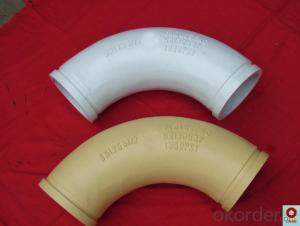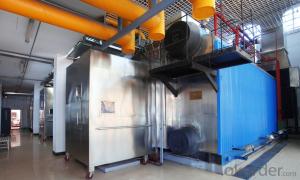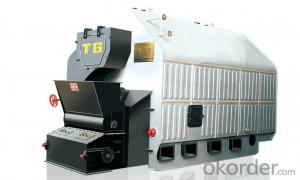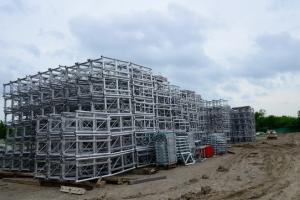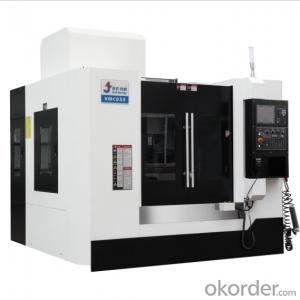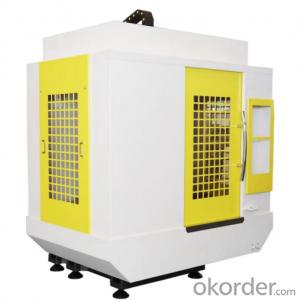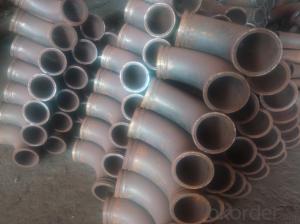CONCRETE DELIVERY ELBOW CIFATYPE 90DEG R275 DN125
- Loading Port:
- Tianjin
- Payment Terms:
- TT OR LC
- Min Order Qty:
- 100 pc
- Supply Capability:
- 10000 pc/month
OKorder Service Pledge
OKorder Financial Service
You Might Also Like
concrete pump elbow table
Wear-resistant Single or Double Concrete Pump Elbow | |||||||
Type | Singe Elbow | Double Elbow | |||||
Model | DN125 | DN150 | DN175 | DN125 | |||
Material | Casting Steel ,ST52 | Inside | 40Cr | Outside | |||
Size | R275*90° | R275*90°+110 | 36° | F2000 | R275*90° | R275*90°+110 | |
R275*45° | R275*90°+211 | R400*30° | A3000 | R275*45° | R275*90°+211 | ||
R275*25° | R275*90°+411 | R400*45° | 471B | R275*25° | R275*90°+411 | ||
R275*20° | R275*90°+424 | R400*30° | 571B | R275*20° | R275*90°+424 | ||
R275*15° | R275*45°+170 | R488*90° | A1000 | R275*15° | R275*45°+170 | ||
R180*90° | R275*45°+310 | R500*90 | C1000 | R180*90° | R275*45°+310 | ||
R232*60° | R275*45°+310 | R280*90° | B2000 | R232*60° | R275*45°+310 | ||
R240*36° | 20°Lengthen | R240*36° | 20°Lengthen | ||||
R240*30° | 25°+740 | R240*30° | 25°+740 | ||||
R240*15° | 40°Zoomlion | R240*15° | 40°Zoomlion | ||||
R385*29° | R385*29° | ||||||
R315*33° | R315*33° | ||||||
Technic | Forged | ||||||
Average life | 25,000cubic | 50,000cubic | |||||
Appliciation | Used in concrete transport in construction work | ||||||
1.product profile:The double layer concrete pump elbow is developed by ourselves through new
technology and process.
2.characteristic:the inner layer of this concrete pump elbow undergoes heat treatment,and then the rigitiry can reach 62-65HRC.
3.characteristic:the outer layer of the concrete pump elbow possess good toughness properties
to protect the inner layer,so the security of the elbow is improved.
4.life:the experiment done abroad shows that the life of our concrete pump elbow can reach 35000-50000cbm,got the customers' praise
5.Beside the double layer concrete pump elbow,we produce all kinds of concrete pump parts,
straight pipe hose flange coupling and so on.
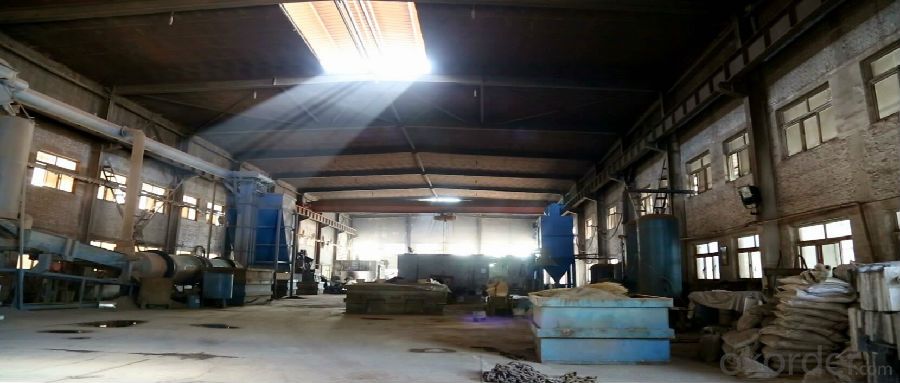
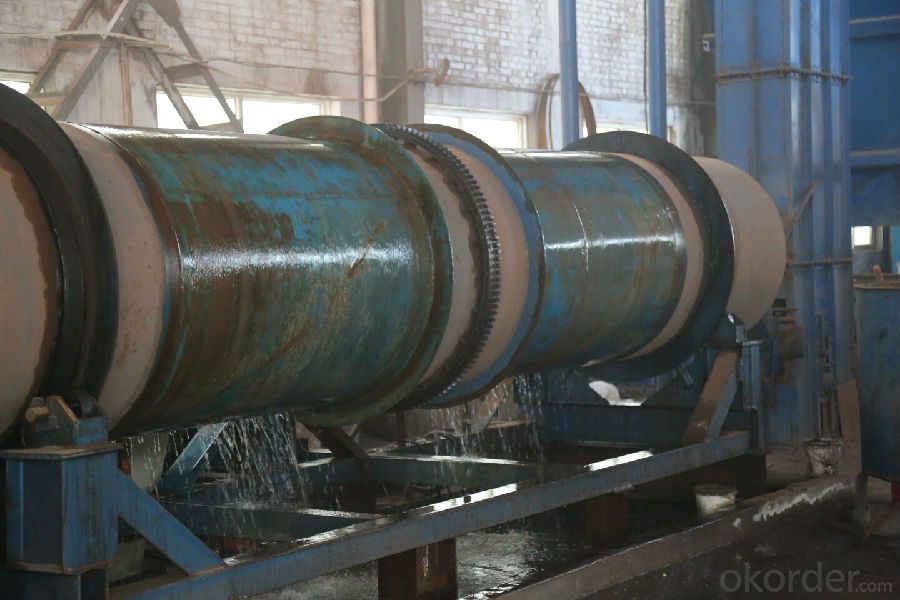

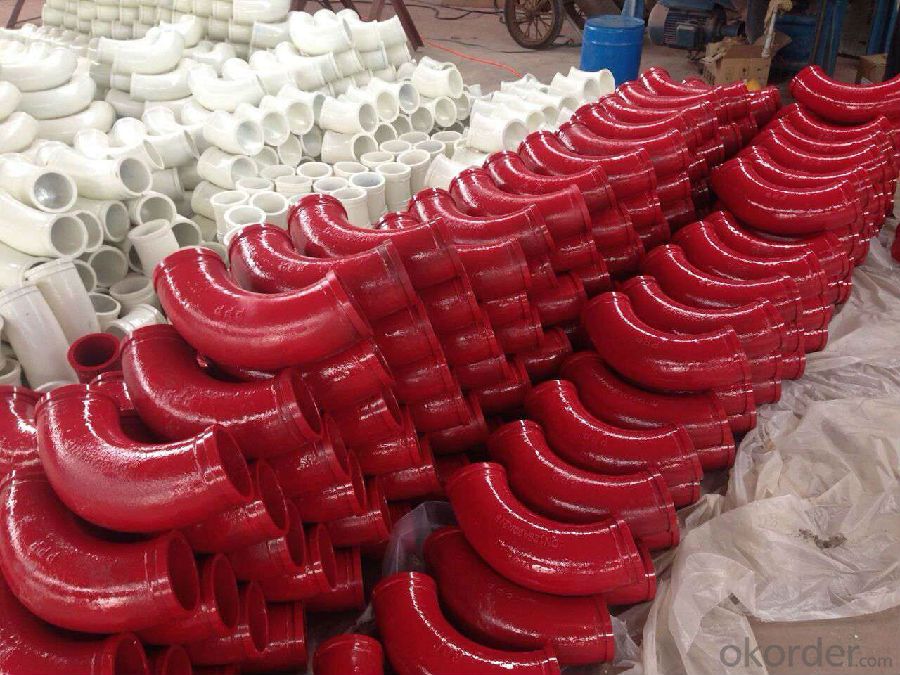
- Q:What are the different types of concrete pump hopper cylinders seals?
- There are several different types of concrete pump hopper cylinder seals, each designed to meet specific needs and requirements. Some of the most common types include: 1. Piston seals: These seals are designed to prevent leakage between the piston and cylinder bore. They are typically made of durable materials such as rubber or polyurethane, and are resistant to abrasion and wear. 2. Rod seals: Rod seals are installed on the piston rod to prevent leakage between the rod and cylinder head. They are often made of materials such as rubber or fabric-reinforced rubber, and provide reliable sealing even under high pressure conditions. 3. Wiper seals: Wiper seals are used to remove dirt, dust, and other contaminants from the piston rod as it retracts into the cylinder. They are typically made of polyurethane or rubber, and are designed to provide effective sealing and protection for the cylinder. 4. Wear rings: Wear rings are used to reduce friction and prevent metal-to-metal contact between the piston and cylinder bore. They are typically made of materials such as bronze or Teflon, and help to extend the lifespan of the cylinder by reducing wear and tear. 5. Backup rings: Backup rings are used in conjunction with other seals to provide additional support and stability. They are typically made of materials such as rubber or PTFE, and help to prevent extrusion and damage to the primary seal. Overall, the selection of the appropriate concrete pump hopper cylinder seal depends on factors such as the specific application, operating conditions, and desired performance characteristics. It is important to choose seals that are compatible with the pumped material, provide effective sealing, and have a long lifespan in order to ensure optimal performance and minimize maintenance requirements.
- Q:What is the first generation pumping technology of concrete pump?
- The failure rate and maintenance cost are very high, and it is easy to delay the progress of the project
- Q:What are the different types of concrete pump hopper cylinders?
- There are several different types of concrete pump hopper cylinders that are commonly used in the construction industry. These cylinders play a crucial role in the operation of concrete pumps by providing the necessary pressure and force to move the concrete through the system. One type of concrete pump hopper cylinder is the single-acting cylinder. This type of cylinder operates by using hydraulic pressure to extend the piston rod, which in turn pushes the concrete out of the hopper and into the pumping system. Single-acting cylinders are known for their simplicity and reliability, making them a popular choice for many construction projects. Another type of concrete pump hopper cylinder is the double-acting cylinder. As the name suggests, this type of cylinder operates in both directions, allowing for a more efficient and powerful pumping process. Double-acting cylinders are capable of pushing the concrete out of the hopper during the extension stroke and pulling the piston rod back during the retraction stroke, resulting in a higher pumping capacity and increased productivity. Additionally, there are also different sizes and capacities of concrete pump hopper cylinders available, ranging from smaller cylinders suitable for smaller construction projects to larger cylinders capable of handling heavy-duty pumping operations. The choice of cylinder size depends on factors such as the volume of concrete to be pumped, the distance and height of the pumping location, and the specific requirements of the project. In conclusion, the different types of concrete pump hopper cylinders include single-acting cylinders and double-acting cylinders. Each type has its own advantages and is suitable for different construction applications. The size and capacity of the cylinder should be chosen based on the specific needs of the project. Ultimately, selecting the right type of cylinder is crucial for ensuring efficient and effective concrete pumping operations.
- Q:How do concrete pump spare parts help in the pumping process?
- Concrete pump spare parts play a crucial role in the pumping process by ensuring the smooth and efficient operation of the equipment. These spare parts, such as seals, cylinders, pistons, and valves, help maintain the integrity of the pump and prevent potential breakdowns or malfunctions. They also assist in controlling the flow and pressure of the concrete, allowing for precise and accurate placement. In summary, concrete pump spare parts are essential components that enhance the reliability, performance, and overall productivity of the pumping process.
- Q:In general, how much concrete will be transported per hour for the concrete pump and the pump?
- The length of day pump 36-62m, the efficiency has little effect, regular work is generally 30-40 cubic / hour
- Q:What are the different types of concrete pump hoses?
- There are generally two types of concrete pump hoses: steel-reinforced hoses and fabric-reinforced hoses. Steel-reinforced hoses are stronger and more durable, suitable for high-pressure applications and long-distance pumping. Fabric-reinforced hoses are lightweight and flexible, ideal for smaller projects and shorter pumping distances.
- Q:Where can I buy concrete pump spare parts?
- You can buy concrete pump spare parts from various suppliers and manufacturers. Some common places to find these spare parts include specialized construction equipment stores, online marketplaces, and directly from the manufacturer's website.
- Q:How often should concrete pump control levers be inspected and replaced?
- Regular inspections should be conducted on concrete pump control levers to ensure they are in proper working order. The frequency of these inspections and any necessary replacements will depend on various factors, such as usage levels, environmental conditions, and the quality of equipment maintenance. As a general rule, it is recommended to inspect the control levers at least once a year. This inspection should involve a thorough examination of the lever mechanism to check for any signs of wear, damage, or malfunction. It is also advisable to inspect the levers after any major repairs or maintenance to ensure they have been correctly reinstalled and are functioning properly. If any issues are identified during the inspection, it is crucial to address them promptly. Depending on the severity of the problem, repairs or replacements may be required. Minor repairs can often be carried out on-site, while more significant issues may necessitate the assistance of a professional technician. Regular maintenance, including lubrication and cleaning, is important for extending the lifespan of the control levers. Following the manufacturer's maintenance and usage guidelines can also help prevent premature wear and damage. Ultimately, the frequency of inspections and replacements may vary based on specific circumstances. It is advisable to consult the equipment's manual or the manufacturer for precise recommendations regarding the maintenance and replacement of the control levers.
- Q:What are the different types of concrete pump rubber hoses?
- There are several different types of concrete pump rubber hoses available in the market. 1. Steel Wire Reinforced Hose: This is the most common type of concrete pump rubber hose. It is reinforced with multiple layers of steel wire to provide maximum strength and durability. Steel wire reinforced hoses are suitable for high-pressure applications and can handle the heavy pumping of concrete with ease. 2. Textile Reinforced Hose: This type of hose is reinforced with multiple layers of textile fabric, such as nylon or polyester. Textile reinforced hoses are generally lighter in weight compared to steel wire reinforced hoses, making them easier to handle and maneuver. They are suitable for medium-pressure applications and are commonly used in smaller concrete pumps. 3. Fabric Hose: Fabric hoses are made from a single layer of fabric, such as nylon or polyester. They are lightweight and flexible, making them easy to handle and transport. Fabric hoses are suitable for low-pressure applications and are commonly used in small-scale construction projects. 4. Composite Hose: Composite hoses are made from a combination of different materials, such as rubber and plastic. These hoses are lightweight and highly flexible, making them suitable for applications where maneuverability is crucial. Composite hoses are commonly used in smaller concrete pumps and can handle both low and medium pressure. 5. Flanged Hose: Flanged hoses have flanges attached at both ends of the hose, which are used to connect the hose to the pump and the nozzle. Flanged hoses provide a secure connection and prevent any leaks or disconnections during the pumping process. They are commonly used in high-pressure applications and are suitable for large-scale construction projects. Overall, the choice of concrete pump rubber hose depends on the specific requirements of the project, including the pressure, size, and type of concrete being pumped. It is important to select the right type of hose to ensure efficient and safe concrete pumping operations.
- Q:How do I properly maintain and replace hydraulic pumps in concrete pump spare parts?
- To ensure the smooth functioning and long life of your equipment, it is crucial to properly maintain and replace hydraulic pumps in concrete pump spare parts. Here are some steps that can assist you in this process: 1. Conduct Regular Inspections: Before and after each use, visually inspect the hydraulic pump to detect any signs of wear, leaks, or damage. Additionally, check for loose bolts, damaged seals, or excessive noise during operation. 2. Adhere to Manufacturer's Guidelines: Consult the manufacturer's guidelines and recommendations regarding the maintenance and replacement of hydraulic pumps. They will provide specific instructions concerning the frequency of maintenance, lubrication, and replacement intervals. 3. Ensure Proper Lubrication: Smooth operation of hydraulic pumps requires proper lubrication. Regularly check the oil levels and refill if necessary. Utilize the recommended oil or hydraulic fluid as specified by the manufacturer. Adhere to the guidelines regarding the frequency of oil changes. 4. Maintain Regular Cleaning: Keep the hydraulic pump and its components free from debris, dust, and dirt. Employ a clean cloth or compressed air to eliminate any accumulated contaminants. This practice will help prevent damage and minimize the likelihood of clogs or blockages. 5. Replace Worn Parts: Over time, certain components of the hydraulic pump may wear out and necessitate replacement. Maintain a stock of spare parts, including seals, gaskets, and filters, to promptly replace any worn or damaged components. 6. Seek Professional Assistance: If you are uncertain about any aspect of maintaining or replacing hydraulic pumps, it is advisable to consult a professional technician or the manufacturer. They possess the expertise and knowledge to guide you through the process and ensure the best maintenance and replacement practices. Remember, regular maintenance and timely replacement of hydraulic pumps in concrete pump spare parts will not only prolong the lifespan of your equipment but also ensure safe and efficient operation on construction sites.
1. Manufacturer Overview |
|
|---|---|
| Location | |
| Year Established | |
| Annual Output Value | |
| Main Markets | |
| Company Certifications | |
2. Manufacturer Certificates |
|
|---|---|
| a) Certification Name | |
| Range | |
| Reference | |
| Validity Period | |
3. Manufacturer Capability |
|
|---|---|
| a)Trade Capacity | |
| Nearest Port | |
| Export Percentage | |
| No.of Employees in Trade Department | |
| Language Spoken: | |
| b)Factory Information | |
| Factory Size: | |
| No. of Production Lines | |
| Contract Manufacturing | |
| Product Price Range | |
Send your message to us
CONCRETE DELIVERY ELBOW CIFATYPE 90DEG R275 DN125
- Loading Port:
- Tianjin
- Payment Terms:
- TT OR LC
- Min Order Qty:
- 100 pc
- Supply Capability:
- 10000 pc/month
OKorder Service Pledge
OKorder Financial Service
Similar products
New products
Hot products
Related keywords
